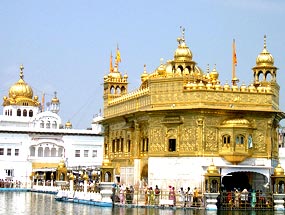Golden Temple of Amritsar is one of the most
revered pilgrim destinations for the Sikh. Explore the Golden Temple
of Amritsar, India.
Golden Temple

Location: Amritsar, Punjab
Official Name: Harmandir Sahib
Founded By: Hazrat Mian Mir
Founded In: 1588-1601
Golden Temple is counted amongst the most revered pilgrimages of the
Sikhs in India. It is located in the Amritsar, one of the most developed
cities of Punjab. Sikh devotees from different parts of the country come
to Amritsar to offer their prayers at the Golden Temple, which is
officially known by the name of Harmandir Sahib. The term 'Harmandir
Sahib' has been derived from two words, Hari meaning 'God' and Mandir
meaning 'Temple'. Thus, Harmandir literally means the 'Temple of God'.
The site where the gurdwara now stands was once the venue of a temple,
surrounded by a small lake and a thin forest. The nearby town of
Goindval served as the residence of the third Sikh Guru, Guru Amar Das.
The great Mughal Emperor Akbar used to come to the town to visit the
Guru. He got so much impressed by the way of life in the town that he
allocated the revenues of several villages lying in the surroundings to
the Guru's daughter, Bhani, as a gift on her marriage to Bhai Jetha.
Bhai Jetha went on to become the fourth Guru of the Sikhs and came to
be known as Guru Ram Das. He enlarged the lake surrounding the temple
and even constructed a small township around it. The town initially came
to be known as 'Guru Ka Chak', 'Chak Ram Das' or 'Ram Das Pura'.
However, the full-fledged town of Amritsar was developed under the
leadership of the fifth Guru, Guru Arjan Dev. Hazrat Mian Mir, a great
Sufi saint of Lahore and a friend of Guru Arjan Dev Ji, laid the
foundation stone of Golden Temple in December 1588.
It took approximately 13 years to construct the monument and it was
completely ready and 1601. The Afghans, under the rule of Ahmed Shah
Abdali, attacked Golden temple and inflicted great damages on it. Owing
to this destruction, the gurdwara had to be substantially rebuilt during
the 1760s. The gurdwara is situated in the middle of a small lake, which
is known as the 'Sarovar'. The devotees believe that the water of the
lake has curative powers and call it as Amrit (The Holy Water).
One can enter the gurdwara complex through any of its four entrances.
The four entrances of Golden Temple are suggestive of the importance of
acceptance and openness in relation to human beings. There is no
restriction on people for entering the gurdwara. People of any religion,
color, creed or sex can enter Harimandir Sahib. The only restraint that
has been applied is that a person must not drink alcohol, eat meat,
smoke cigarettes or consume any drugs while inside the premises of the
shrine.
Just like in any other gurdwara, people entering the Golden Temple have
to cover their heads as a sign of respect. They are also required to
wash their feet in the small pool of water before entering the sanctum
sanctorum. Built on a 67 sq ft. square platform, Harmandir Sahib covers
an area of 40.5 sq ft. At the end of the walkway is Darshani Deori (an
arch), with a doorframe that is approximately 10 ft in height and 8ft
6in in breadth. The door panes are adorned with artistic style and lead
to the ramp taking to the main building.
13 feet wide 'Pardakshna' (circumambulatory path) runs around the main
shrine and leads to the 'Har ki Paudi' (steps of God). The main building
of Golden Temple has three stories, with their front facing the bridge.
The central hall is small square room with three entrances. A recitation
of Guru Granth Sahib is held here on a regular basis. Just above this
room is the low fluted dome, adorned with lotus petal motif. On the top
of it is an inverted lotus, the 'Kalash' with a beautiful 'Chhatri'.
Golden Temple is festooned with decorative gilding and marble work,
which date back to the 1800s. The magnificent gold work and marble work
was done under the reign of Ranjit Singh, the Maharaja of the Sikh
Kingdom of Punjab. The architecture of the gurdwara represents an
exceptional harmony between the Muslim and the Hindu architectural
styles. Infact, it is said that the architecture of Harmandir Sahib has
created an independent Sikh school of architecture in the Indian
subcontinent.
After Operation Black Thunder of 1988, Government acquired a narrow
peripheral strip of land surrounding the gurdwara. This was done for the
purpose of creating a security belt. This led to displacement of a large
number of people and as a result, large scale protests. The project was
discontinued at that time and was revived only in 1993 by the Deputy
Commissioner Karan Bir Singh Sidhu. He changed the concept of the
periphery, from that of a security belt to that of a second parikarma.
A serene landscape, fully consistent with the beauty of the Golden
Temple, was also created. The pilgrims visiting the Golden Temple can
only travel by foot in the Galliara, vehicles are not permitted. On 6th
July 2005, the SGPC (Shiromani Gurdwara Parbandhak Committee) decided to
install closed circuit television cameras around the Harmandir Complex
for security purposes.


